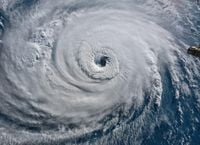As Cyclone Montha barreled across India’s eastern coast late Tuesday, millions braced for impact in what has become a harrowing testament to the increasing ferocity of weather events across South Asia. According to the Associated Press, the Indian Meteorological Department (IMD) confirmed that Montha began making landfall around 7 p.m. on October 28, 2025, bringing with it torrential rains and winds clocking up to 110 kilometers per hour (about 68 mph). The storm’s eye crossed the Andhra Pradesh coast near Antarvedi village in the Konaseema district, just south of the port city of Kakinada, before weakening into a deep depression as it moved inland toward Telangana and Chhattisgarh.
Authorities wasted no time. In Andhra Pradesh alone, disaster teams evacuated nearly 76,000 people from low-lying coastal areas to 1,906 relief camps and 364 school shelters. The state government estimated that roughly 4 million people resided in the cyclone’s vulnerable path. Schools and colleges were ordered to remain closed until at least Wednesday, and fishermen were sternly warned to avoid venturing out to sea. Trains and flights faced partial disruption, while power outages and waterlogged roads quickly became the norm in affected towns.
Chief Minister N. Chandrababu Naidu, after conducting an aerial survey of the hardest-hit regions, assured residents, “We are assessing the impact of Cyclone Montha on the state on an hourly basis. We are fully prepared to face any situation.” In a subsequent press release, Naidu acknowledged the human toll: “If we work in the same way for another two days, we can give much relief to people. Due to the cyclone, two persons died.” Officials later confirmed a total of three fatalities in Andhra Pradesh and Telangana, alongside the loss of 42 livestock.
Neighboring states scrambled to respond as well. In Odisha, the administration shifted approximately 32,000 people to safety, and the IMD issued red alerts for 19 districts in Andhra Pradesh, forecasting extremely heavy rains through the night of October 28 and into the following day. Telangana, Odisha, and Chhattisgarh braced for moderate to heavy showers, with heavy rainfall also forecast for Gangetic West Bengal, Bihar, and Jharkhand in the days to follow. The IMD’s Bhubaneswar director, Manorama Mohanty, reported that “in the last 24 hours, in the state of Odisha, 25 places reported heavy rainfall, and two places reported very heavy rainfall, and the highest maximum rainfall was reported in the district of Gajapati, 150.5 millimetres.”
The cyclone’s trajectory, initially expected to make landfall near Kakinada, shifted slightly to Amalapuram, sparing Odisha from the worst-case scenario. Odisha’s Revenue and Disaster Management Minister, Suresh Pujari, expressed gratitude for the change, noting, “The change in the cyclone’s trajectory spared Odisha from severe devastation.” Nevertheless, the state was not entirely unscathed—landslides, damaged roads, and flooded homes were reported in several southern districts.
In Andhra Pradesh, the devastation was palpable. According to preliminary estimates presented to Chief Minister Naidu, crops across 87,000 hectares (over 215,000 acres) were damaged, including paddy, maize, cotton, and black gram. Additionally, 380 kilometers of roads and 14 bridges sustained damage, and 59,000 hectares remained waterlogged, affecting nearly 79,000 farmers. In Konaseema district, banana plantations were flattened, and in Guntur, strong winds uprooted trees and downed electric poles, disrupting traffic and power supply. The government’s rapid deployment of 11,000 energy department employees, 1,447 earthmovers, 321 drones, and over 1,000 chainsaws helped speed up restoration efforts. Chief Secretary K. Vijayanand promised, “100 percent power supply will be restored on Thursday.”
Relief operations have been a collaborative effort, with YSR Congress Party leaders, local officials, and volunteers working tirelessly. From Srikakulam to Tirupati, teams visited affected villages, arranged food and shelter, and collected damage reports for ongoing review. Special attention was given to vulnerable groups, with over 2,000 pregnant women safely sheltered in maternity homes across Andhra Pradesh.
Telangana, too, felt Montha’s wrath. Heavy rains inundated districts such as Warangal, Jangaon, and Hyderabad, causing widespread waterlogging and bringing traffic to a standstill in Hyderabad’s IT corridor. Schools and colleges in several districts were shut as a precaution, and disaster management teams established control rooms across the state to monitor the evolving situation. The IMD issued a red alert for Mulugu, Khammam, and B Kothagudem, and an orange alert for several other districts, warning of continued heavy rainfall and gusty winds.
In the cyclone’s aftermath, the environmental impacts became evident. Along the Mangaluru coastline, heaps of debris and plastic waste were washed ashore, while in Odisha’s Koraput district, landslides and road blockades hampered relief efforts. The IMD emphasized that Montha’s remnants would continue to bring rain and thunderstorms to regions as far as Gujarat, Maharashtra, and West Bengal through early November.
Climate scientists have long warned that South Asia’s vulnerability to severe cyclones is increasing. As Akshay Deoras, a meteorologist at the University of Reading, explained to the Associated Press, “Global warming is increasing the air temperature and is also making oceans warm. And if an ocean is very warm, it is going to supply a lot of energy to any tropical storm over the ocean.” Warmer oceans act as fuel, intensifying storms and making them more unpredictable—a trend observed with Cyclone Montha and earlier disasters. India, already among the world’s largest emitters of greenhouse gases, is also one of the most at risk from climate impacts. In 2024 alone, Asia experienced 167 disasters, with losses exceeding $32 billion, according to the Emergency Events Database maintained by the University of Louvain.
While the toll from Montha was mitigated by swift government action and community resilience, the storm’s impact serves as a sobering reminder of the region’s exposure to climate-driven extremes. As the skies begin to clear and the arduous task of rebuilding commences, many are left pondering how much longer communities can weather the storm—quite literally—in an era of intensifying climate risks.

